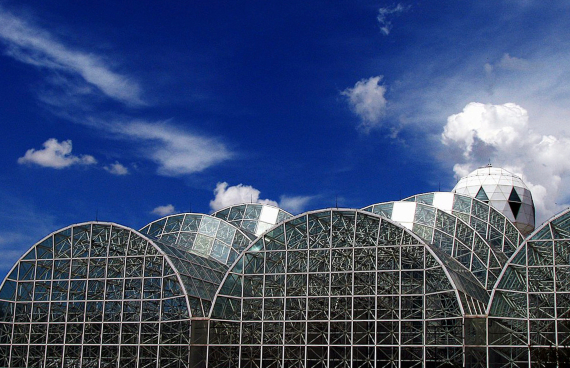The story goes that back in 1909, Buffalo Bill trekked 150 miles in the lands around the town of Oracle, in the Santa Catalina Mountains of the Arizona Territory, in search of gold mines in which to invest the profits from his successful Wild West show. Eight decades later, a very different, but no less valuable, return would be sought from that land. Oracle is the site of Biosphere 2, one of the most audacious projects in history, from which it was hoped to obtain the blueprint for constructing a human home on Mars. It is well known that the attempt to build a closed, self-sufficient ecosystem failed, but that was not the end of the road for Biosphere 2. In a different way the project lives on, and today its research can help us address current pressing challenges such as climate change.
Biosphere 2 did not originally emerge as the grand academic science project one might imagine, but rather as a futuristic utopia not without entrepreneurial vision; or, as the Los Angeles Times put it, “a volatile blend of New Age idealism and corporate sophistication.” Its origin lay not in a university laboratory, but in a hippie commune: Synergia Ranch, an ecovillage founded in 1969 in New Mexico by the eccentric engineer, environmentalist, playwright and entrepreneur John Polk Allen.
A planet in a bottle
From the “Spaceship Earth” concept popularised by inventor Buckminster Fuller, Allen began to develop the ideas that attracted the interest and financial support of the equally eccentric billionaire philanthropist Edward Perry Bass. With the participation of other pioneers in Allen’s group, 1984 saw the birth of Space Biospheres Ventures, which announced its project to build at Oracle, near Tucson, a second, smaller version of the Earth’s biosphere—Biosphere 2—a “planet in a bottle”, according to the LA Times, that would provide insight into the planet’s ecological degradation and serve as a dress rehearsal for a future habitat in space or on other worlds such as Mars. For Allen it was much more, the first step towards a new civilisation to replace the one he considered already dead.
Construction began in 1987, and in September 1991 eight “biospherians” were finally enclosed in its 12,800 square metres of floor space separated from the outside by 16,000 m2 of geodesic glass domes and cupolas. It was a materially closed, energetically open life-support system with some 20 tonnes of living biomass totalling 4,000 species in seven different habitats, all designed to produce food, drinking water and breathable air to last for no less than a century. But its creators expected Biosphere 2 to produce something more: like Buffalo Bill’s gold mine, money, which would come from patents, from the construction of new biospheres and, of course, from tourism. It did become a popular attraction; the guides who led visitors around the perimeter of the facility proudly recounted that theirs was the second most visited site in Arizona, behind only the Grand Canyon.
However, the 100 years ended up being just two. In September 1993, the biospherians’ confinement came to an end; the production of food, oxygen and drinking water had all failed, species were dying off, the plants were withering and cockroaches were taking over. Public and media enthusiasm faded, or even turned to derision when it was revealed that Biosphere 2 was regularly supplied from the outside, that oxygen had been pumped in to keep the occupants from suffocating to death, and that a CO2 scrubber had been installed that also relied on non-renewable refills. “Bogus New World?” snarked the headline of the Washington Post. The voices of those who from the outset had criticised the project’s lack of scientific basis grew shrill: “It’s not science at all,” said biologist Lynn Margulis, a pioneer of biospheric science. The media dropped hints about the kind of ideas Allen used to impart to his followers at Synergia Ranch, such as rejecting the nuclear family, howling in groups or maintaining silence during meals.
New approach: a climate change simulator
Within the project itself, the problems were not merely technical: the eight biospherians split into two irreconcilable camps, and the turbulence led to a feud between Allen and Bass. The company was disbanded in 1994, when a new team was installed within the facility. This second mission was aborted after only six months. In the midst of a tangle of lawsuits and an act of sabotage perpetrated by two of the first biospherians—they explained that the occupants’ lives were in danger—the entry of investor Steve Bannon into the project finally put the facility in the hands of Columbia University.

rom 1995 to 2003, researchers from Columbia imposed a more scientific approach, abandoning the idea of the closed ecosystem and turning Biosphere 2 into a climate change simulator by manipulating CO2 levels. These studies were instrumental in showing that increased CO2 and the resulting acidification of the oceans are far more devastating to coral reefs than previously thought.
In 2007 the University of Arizona took over the research at Biosphere 2, and finally obtained full ownership of the structure in 2011 thanks to a donation, which removed the threat of demolition that had been hanging over the head of such an iconic facility. Today Biosphere 2 is still alive and visitable, after the shutdown necessitated by the COVID-19 pandemic. And science continues to advance under its glass domes. At the moment, the effects of drought and the rise in CO2 and temperature on the rainforest ecosystem are being studied, as well as how the soil is evolving. But there are bigger plans too: the Space Analog for the Moon and Mars (SAM2), a new facility that resurrects the old goal of testing the feasibility of a lunar or Martian habitat, is currently under construction there. Perhaps the psychedelic dream of Allen and Bass will finally take flight.
Comments on this publication